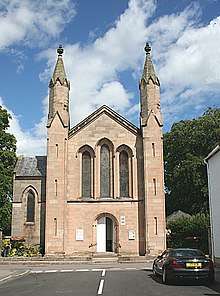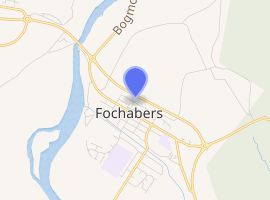Gordon Chapel
Gordon Chapel is a nineteenth century church in Fochabers, Scotland. It is part of the Scottish Episcopal Church, under the governance of the United Diocese of Moray, Ross and Caithness. Designated as a category A listed building, it was originally built in the 1830s by Archibald Simpson under the patronage of the last Duchess of Gordon. Extensively renovated by Alexander Ross in the 1870s, it features the largest collection of Pre-Raphaelite stained glass windows in Scotland.
| Gordon Chapel | |
|---|---|
 The south facade, with main entrance | |

| |
| Location | Fochabers |
| Country | Scotland |
| Denomination | Scottish Episcopal Church |
| History | |
| Founded | 19th century |
| Architecture | |
| Functional status | Active |
| Heritage designation | Category A listed building |
| Clergy | |
| Minister(s) | Rev Michael Last |
History
The church was built at a cost of £900[1] from 1832 to 1834, according to a design by the noted Scottish architect Archibald Simpson,[2] who was responsible for the construction of many of the notable buildings in nearby Aberdeen. The building was paid for by Elizabeth Brodie,[3] wife of the fifth Duke of Gordon. Gordon Castle, which was the principal seat of the Dukes of Gordon, is near Fochabers, but only partly survives.
The first floor chapel was dedicated on 12 August 1834, some three months after a school had opened on the ground floor of the building,[4] in the space that was later to become the parsonage.
Elizabeth Brodie was an Episcopalian at the time the church was built, but since she was born in London and her household, servants and many of her visitors were from England, she favoured services that followed the English Book of Common Prayer over the Scottish Episcopal liturgy. Controversies around this, and over whether it should be subject to the 'government and inspection' of the Scottish church, eventually resulted in Brodie deciding to close the church in 1848. Local Episcopalians, now without a place to worship and concerned that the building should fall into disrepair, petitioned her in 1852 to allow them use of the building again. Brodie, who by this time had joined the Free Church of Scotland, agreed to make the church and school over to her Episcopalian nephew, Charles Gordon-Lennox, the Duke of Richmond,[4] and the church was reopened.
Gordon-Lennox was succeeded by his son (also Charles) in 1860, who commissioned substantial improvements and renovations to the building by Alexander Ross,[3] including the installation of a hammerbeam roof.[5] The building remained in the hands of the Gordon-Lennox family until 1937, when it was sold by the ninth Duke to the Crown Estate. [6] Worship in the building was suspended during the second world war, and at one point troops were billeted within it; after the war, the Crown Estate considered selling it to house a cinema, but the congregation managed to raise the funds to purchase the building in 1950, and its use as a place of worship recommenced.[6][7]
The building was again subject to renovation work from 2008, when all its windows were removed for safekeeping and restoration during the construction of a bypass road nearby. They were reinstalled and the building reopened in 2012.[8]
Design
The building is a two-level gothic design, with the parsonage (originally a school) on the ground floor and the chapel itself on the floor above that. It is oriented north-south, with the main entrance, leading onto Castle Street, on the south end[3] which is faced with ashlar sandstone, while the rest of the building is harled.[8] A projection in the north-west corner was originally a private entrance for the Gordon family.[9]
The chapel boasts the largest collection of Pre-Raphaelite stained glass windows in Scotland,[9] produced by Morris and Co, some designed by Sir Edward Burne-Jones.[3] These include depictions of the Crucifixion (1874), Saint Cecilia (1879), Saint Ursula (1887), the archangel Raphael (1902), Christ as the Good Shepherd (1903) and the archangel Michael (1914). The St Michael window is dedicated to Bernard Charles Gordon-Lennox, third son of the seventh Duke of Richmond, who was killed in fighting near Ypres in November 2014, aged 36, during the First World War.[10]
Current usage
The church is still an active place of worship, and is part of the Diocese of Moray, Ross and Caithness of the Scottish Episcopal Church, with weekly services celebrated by Rev Michael Last.[7] The chapel is accessed by a flight of stairs, but services are relayed by CCTV to the chapel room on the ground floor to allow people with mobility issues to partake in them.[11]
References
- "Fochabers, Gordon Episcopal Chapel And Parsonage". Canmore.org. Historic Environment Scotland. Retrieved 17 March 2019.
- "Gordon Episcopal Chapel and Chapel House". Dictionary of Scottish Architects. Dictionary of Scottish Architects. Retrieved 17 March 2019.
- Historic Environment Scotland. "Fochabers, Castle Street, Gordon Chapel (Episcopal Church) and Gordon Chapel House (parsonage) (LB1549)". Retrieved 15 April 2019.
- "History". Gordon Chapel Fochabers. Retrieved 17 March 2019.
- Hume, John R. (2005). Scotland's Best Churches. Edinburgh: Edinburgh University Press. p. 91. ISBN 0748621792.
- "History – III". Gordon Chapel Lochabers. Gordon Chapel Lochabers. Retrieved 17 March 2019.
- "Gordon Chapel, Fochabers". United Diocese of Moray, Ross and Caithness. United Diocese of Moray, Ross and Caithness. Retrieved 18 March 2019.
- "Gordon Episcopal Chapel". Places of Worship in Scotland. Scottish Church Heritage Research Ltd. Retrieved 17 March 2019.
- Walker and Woodworth (2015). The Buildings of Scotland – Aberdeenshire North and Moray. Newhaven and London: Yale University Press. pp. 618–619. ISBN 9780300204285.
- Gore, Jan (2017). Send More Shrouds. Pen and Sword. p. 91. ISBN 1473851505. Retrieved 17 March 2019.
- "Gordon Chapel, Fochabers". Scotland's Churches Trust. Scotland's Churches Trust. Retrieved 17 March 2019.